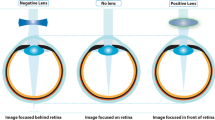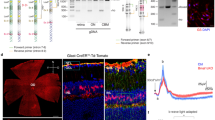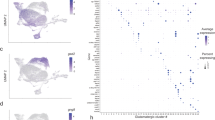Abstract
Ocular growth and refraction are regulated by visual processing in the retina. We identified candidate regulatory neurons by immunocytochemistry for immediate-early gene products, ZENK (zif268, Egr-1) and Fos, after appropriate visual stimulation. ZENK synthesis was enhanced by conditions that suppress ocular elongation (plus defocus, termination of form deprivation) and suppressed by conditions that enhance ocular elongation (minus defocus, form deprivation), particularly in glucagon-containing amacrine cells. Fos synthesis was enhanced by termination of visual deprivation, but not by defocus and not in glucagon-containing amacrine cells. We conclude that glucagon-containing amacrine cells respond differentially to the sign of defocus and may mediate lens-induced changes in ocular growth and refraction.
This is a preview of subscription content, access via your institution
Access options
Subscribe to this journal
Receive 12 print issues and online access
$209.00 per year
only $17.42 per issue
Buy this article
- Purchase on Springer Link
- Instant access to full article PDF
Prices may be subject to local taxes which are calculated during checkout






Similar content being viewed by others
References
Wallman, J. Retinal control of eye growth and refraction. Prog. Retinal Res. 12, 133–153 ( 1993).
Fischer, A. J., Seltner, R. L. & Stell, W. K. NMDA-induced excitotoxicity causes myopia in post-hatch chicks. Can. J. Ophthalmol. 32, 373– 377 (1997).
Fischer, A. J., Miethke, P., Morgan, I. G. & Stell, W. K. Cholinergic amacrine cells are not required for the progression and atropine-mediated suppression of form-deprivation myopia. Brain Res. 794, 48–60 (1998).
Fischer, A. J., Seltner, R. L., Poon, J. & Stell, W. K. Immunocytochemical characterization of NMDA and QA-induced excitotoxicity in the retina of chicks. J. Comp. Neurol. 393, 1– 15 (1998).
Fischer, A. J., Seltner, R. P. L. & Stell, W. K. Opiate and N-methyl-D-aspartate receptors in form-deprivation myopia. Vis. Neurosci. 15, 685– 693 (1998).
Fischer, A. J., Morgan, I. G. & Stell, W. K. Colchicine induces excessive ocular growth and myopia in chicks. Vision Res. 39, 685– 697 (1999).
Wildsoet, C. & Pettigrew, J. D. Kainic acid-induced eye enlargement in chickens: Differential effect on anterior and posterior segments. Invest. Ophthal. Vis. Sci. 29, 311– 319 (1988).
Curtin, B. J. The Myopias: Basic Science and Clinical Management (Harper & Row, Philadelphia, 1985).
Wallman, J. Nature and nurture of myopia. Nature 371, 201–202 (1994).
Beckman, A. M. & Wilce, P. A. Egr transcription factors in the nervous system. Neurochem. Int. 31, 477–510 (1997).
Chaudhuri, A. Neural activity mapping with inducible transcription factors. Neuroreport 8, iii–vii ( 1997).
Long, K. D. & Salbaum, J. M. Evolutionary conservation of the immediate-early gene ZENK. Mol. Biol. Evol. 15, 284–292 (1998).
Sukhatme, V. P. et al. A zinc finger-encoding gene coregulated with c-fos during growth and differentiation, and after cellular depolarization. Cell 53, 37–43 ( 1988).
Lemaire, P., Revelant, O., Bravo, R. & Charnay, P. Two genes encoding potential transcription factors with identical DNA-binding domains are activated by growth factors in cultured cells. Proc. Natl. Acad. Sci. USA 85, 4691–4695 ( 1988).
Milbrant, J. A nerve growth factor-induced gene encodes a possible transcriptional regulatory factor. Science 238, 797– 799 (1987).
Dragunow, M. & Faull, R. The use of c-fos as a metabolic marker in neuronal pathway tracing. J. Neurosci. Methods 29 , 261–265 (1989).
Gudehithlu, K. P., Neff, N. H. & Hadjiconstantinou, M. c-fos and NGFI-A mRNA of rat retina: evidence for light-induced augmentation and a role for cholinergic and glutamate receptors. Brain Res. 631, 77–82 ( 1993).
Araki, C. M. & Hamassaki-Britto, D. E. Motion-sensitive neurons in the retina: a study using Fos immunohistochemistry. Brain Res. 794, 333–337 ( 1998).
Masana, M. I., Benloucif, S. & Dubocovich, M. L. Light-induced c-fos mRNA expression in the suprachiasmatic nucleus and the retina of C3H/HeN mice. Mol. Brain Res. 42,193–201 (1996).
Rohrer, B., Iuvone, P. M. & Stell, W. K. Stimulation of dopaminergic amacrine cells by stroboscopic illumination or fibroblast growth factor (bFGF, FGF-2) injections: possible roles in prevention of form-deprivation myopia in the chick. Brain Res. 686, 169–181 ( 1995).
Sagar, S. M. & Sharp, F. R. Light induces a Fos-like nuclear antigen in retinal neurons. Mol. Brain Res. 7, 17–21 (1990).
Yaqub, A., Guimaraes, M. & Eldred, W. D. Neurotransmitter modulation of Fos- and Jun-like proteins in the turtle retina. J. Comp. Neurol. 354 , 481–500 (1995).
Yoshida, K., Kawamura, K. & Imaki, J. Differential expression of c-fos mRNA in rat retinal cells: Regulation by light/dark cycle. Neuron 10, 1049–1054 (1993).
Koistinaho, J. & Sagar, S. M. Localization of protein kinase C subspecies in the rabbit retina. Neurosci. Lett. 177, 15–18 ( 1994).
Kolb, H., Zhang, L. & DeKorver, L. Differential staining of neurons in the human retina with antibodies to protein kinase C isozymes. Vis. Neurosci. 10, 341–351 (1993).
Ueda, Y., Iwakabe, H., Masu, M., Suzuki, M. & Nakanishi, S. The mGluR6 5´-upstream transgene sequence directs a cell-specific and developmentally regulated expression in retinal rod and ON-type cone bipolar cells. J. Neurosci. 17, 3014–3023 (1997).
Kuwayama, Y. et al. Overall distribution of glucagon-like immunoreactivity in the chicken retina: an immunohistochemical study with flat mounts. Invest. Ophthal. Vis. Sci. 22, 681– 686 (1982).
Schmid, K. L. & Wildsoet, C. F. Effects on the compensatory responses to positive and negative lenses of intermittent lens wear and ciliary nerve section in chicks. Vision Res. 36, 1023–1036 (1996).
Schaeffel, F. & Diether, S. The growing eye—an autofocus system that works on very poor images. Vision Res. 39, 1585–1589 (1999).
McBrien, N. A., Moghaddam, H. O., Cottriall, C. L., Leech, E. M. & Cornell, L. M. The effects of blockade of retinal cell action potentials on ocular growth, emmetropization and form deprivation myopia in young chicks. Vision Res. 35, 1141–1152 (1995) .
Wildsoet, C. & Wallman, J. Choroidal and scleral mechanisms of compensation for spectacle lenses in chicks. Vision Res. 35, 1175–1194 (1995).
Rohrer, B., Spira, A. W. & Stell, W. K. Apomorphine blocks form-deprivation myopia in chickens by a dopamine D2-receptor mechanism acting in retina or pigmented epithelium. Vis. Neurosci. 10, 447– 453 (1993).
Owusu-Yaw, V., Kyle, A. L. & Stell, W. K. Effects of lesions of the optic nerve, optic tectum and nervus terminalis on rod precursor proliferation in the goldfish retina. Brain Res. 576, 220–230 (1992).
Fischer, A. J. & Stell, W. K. Localization and identification of different isoforms of nitric oxide synthase in the chick eye. J. Comp. Neurol. 405, 1– 14 (1999).
Ramon y Cajal, S. R. in The Structure of the Retina (eds. Thorpe, S. A. & Glickstein, M.) 76–92 (Thomas, Springfield, 1972).
Uchiyama, H. & Ito, H. Target cells for the isthmo-optic fibers in the retina of the Japanese quail. Neurosci. Lett. 154, 35–38 (1993).
Crossland, W. J. & Hughes, C. P. Observations on the afferent and efferent connections of the avian isthmo-optic nucleus. Brain Res. 145, 239–256 (1978).
de la Villa, P., Kurahashi, T. & Kaneko, A. L-glutamate-induced responses and cGMP-activated channels in three subtypes of retinal bipolar cells dissociated from the cat. J. Neurosci. 15, 3571–3582 (1995).
Grünert, U., Martin, P. R. & Wässle, H. Immunocytochemical analysis of bipolar cells in the macaque monkey retina. J. Comp. Neurol. 348, 607–627 (1994).
Brandstätter, J. H., Hartveit, E., Sassoë-Pognetto, M. & Wässle, H. Expression of NMDA and high-affinity kainate receptor subunit mRNAs in the adult rat retina. Eur. J. Neurosci. 6, 1100 –1112 (1994).
Hartveit, E. et al. Localization and developmental expression of the NMDA receptor subunit NR2A in the mammalian retina. J. Comp. Neurol. 348, 570–582 (1994).
Vaney, D. The mosaic of amacrine cells in the mammalian retina. Prog. Retinal Res. 9, 49–100 ( 1990).
Vaney, D. I. Patterns of neuronal coupling in the retina. Prog. Retinal Res. 13, 301–355 ( 1993).
Dowling, J. E. The Retina: An Approachable Part of the Brain (Belknap/Harvard, Cambridge, Massachusetts, 1987).
Acknowledgements
This research was supported by a studentship from the Alberta Heritage Foundation for Medical Research and a University of Calgary Silver Anniversary Graduate Fellowship to A.J.F., grants from the Alberta Children's Hospital Foundation, the University of Calgary Research Grants Committee and the Marigold Foundation of Calgary to W.K.S. and the Max Planck Prize to F.S.
Author information
Authors and Affiliations
Corresponding author
Rights and permissions
About this article
Cite this article
Fischer, A., McGuire, J., Schaeffel, F. et al. Light- and focus-dependent expression of the transcription factor ZENK in the chick retina. Nat Neurosci 2, 706–712 (1999). https://doi.org/10.1038/11167
Received:
Accepted:
Issue Date:
DOI: https://doi.org/10.1038/11167
This article is cited by
-
Ginkgo biloba extracts improve choroidal circulation leading to suppression of myopia in mice
Scientific Reports (2023)
-
The Role of Retinal Dysfunction in Myopia Development
Cellular and Molecular Neurobiology (2023)
-
Experimentally induced myopia and myopic astigmatism alter retinal electrophysiology in chickens
Scientific Reports (2022)
-
Short-term effect of orthokeratology lens wear on choroidal blood flow in children with low and moderate myopia
Scientific Reports (2022)
-
Genome-wide analysis of retinal transcriptome reveals common genetic network underlying perception of contrast and optical defocus detection
BMC Medical Genomics (2021)



